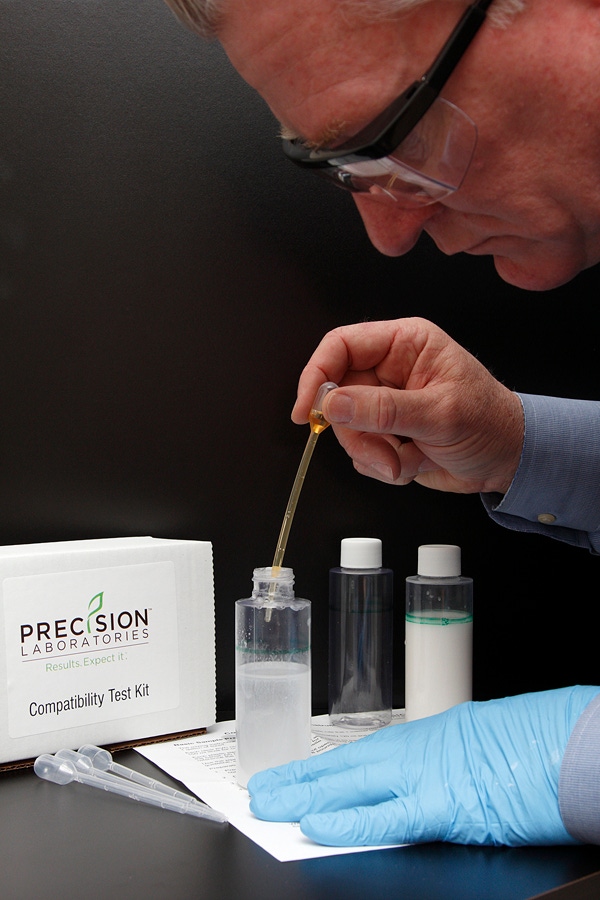
Think DifferentGet information from sources you trust, develop your plan, read the label carefully and then test. Precision Laboratories has a tank mix test kit ($9.95) for accurate mix evaluations of liquid and dry ingredients.Take your time when adding products, advises Eric Spandl, WinField. "Some products take time to get into suspension, especially early season with cool water," he says. "Put a product in the tank, then go check your email, have some coffee and then come back."Use the inductor as a funnel for individual products, not as a premixer, warns Jim Reiss, Precision Laboratories. "Dumping all the products together something that even pro product formulators cannot do."Start with water. "We used to say start with 20 percent water, but with some newer products, it should be something like 80 percent," advises Reiss. "More water helps."
March 26, 2014

Long past are the days of tossing in a little crop oil or surfactant in a spray mix. Selecting the right adjuvant is increasingly important today. However, complex herbicide mixes to fight resistant weeds make proper adjuvant selection a critical part of a successful crop protection program.
"We have more classes of chemistries with ever greater concern for deposition and reduced off-target drift," says Eric Spandl, technical marketing manager, WinField. "As we go forward with new dicamba and 2,4D technologies and tank mixes with glyphosate and other products, it will get more complex. The days of simplicity are over."
West Central, Inc., has developed adjuvants for the past 14 years. Product development manager Brian Kuehl points to past trends in adjuvants and how resistant weeds are changing the priorities. Some adjuvants were oil loving to match one chemistry, while others were water loving to match another chemistry. Still others were hybrids to accommodate very different chemistries and needs in a tank mix.
Tank mix trade-offs
"It is a balancing act," says Kuehl. "In the past, if glyphosate was in a tank mix, we would recommend an adjuvant that optimized glyphosate activity, as it was doing 90% of the work. With resistant weeds, you may want to optimize the activity of a tank-mix partner and give up some glyphosate performance."
Increased specialization of adjuvants also adds complexity. Water quality importance has created demand for adjuvants to counter problems like salts, which can antagonize glyphosate, and pH ranges, that can speed breakdown of insecticidal active ingredients. Even the weed being sprayed can influence adjuvant selection.
"You can clean up the water at its source, but a number of weeds carry calcium on the surface of the leaf, and that calcium can contaminate a herbicide when it hits and cause antagonism without the right adjuvant being added," says Kuehl.
Shifting adjuvant priorities
As Spandl suggests, adding new/old chemistries to the mix is shifting adjuvant priorities again. Jim Reiss, vice president, Agricultural Chemistries, Precision Laboratories, notes that both the new dicamba and 2,4D technologies have very specific requirements to enhance spray quality, and a lot of existing adjuvants can’t be used.
"We are working on replacements for ammonium sulfate," says Reiss. "Drift control is going to be important too. That's where we are spending 70% of our research effort."
If the complexities seem overwhelming, the experts agree on a simple solution. "Go to your local agronomist," says Spandl. "They have experience with the different products applied to the weeds in your area. Ask what is best for your situation and needs."
"While it is difficult even for local retailers to always pick the right adjuvant, they will carry a lineup of products, whether ours or someone else's, that fit your geographic needs," says Kuehl. "Be careful about purchasing products from an unfamiliar source."
That is especially true of imported glyphosate and other off-patent chemistries. While the amount of active ingredient has to be identified on the label, what is unknown is what adjuvants or surfactants might be included.
Watch your sequence
Even with the right products, the right adjuvants and water conditioners, problems can still occur if not added in the right sequence. "We've been used to only one adjuvant with water soluble glyphosate. Now, with all the things being mixed in for resistant weeds, getting the sequence right is a big part of it," advises Reiss.
Precision Laboratories has a free Mix Tank smartphone app designed to help resolve mixing sequence questions and much more. The database includes more than 1,300 crop protection products from more than 17 manufacturers. However, as good as the award-winning app is, Reiss admits that it can't answer every question or prevent problems.
"The app will tell you the right mixing sequence, but it may not tell you if something is flat out incompatible," he warns. "When doing a complex tank mix, always do a compatibility test first. It lets you see what could happen if a mix sits overnight or over a weekend. Suspension concentrates can be stable in the jug with the product, but in the spray solution, they may settle out in as little as 45 minutes."
Spandl endorses the importance of compatibility tests. "There are so many different tank mixes, no one can know if they all work," he advises. " Take a little product and add it to a quart of water. It's better to end up with a quart of cottage cheese versus 1,000 gallons of it."
About the Author(s)
You May Also Like



